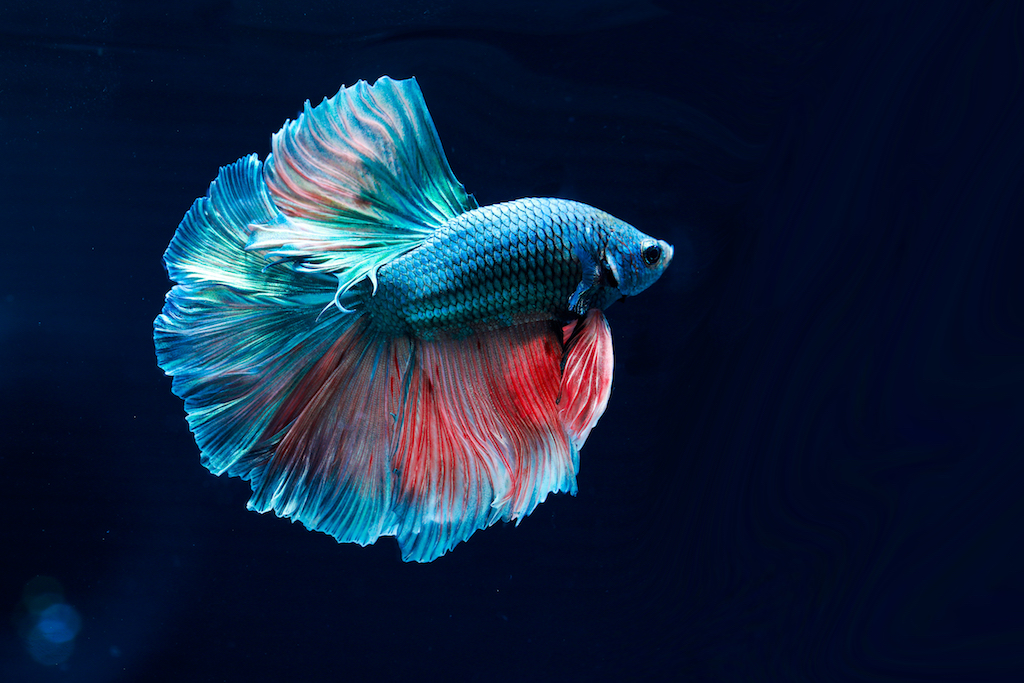Betta Fish: The Dazzling Siamese Fighting Fish
Reference Article: Facts about betta fish.

Betta fish, also called Siamese fighting fish, are small, colorful fish that are native to Southeast Asia and common in the pet trade.
In Thailand, people call betta fish "pla kat," which means "fighting fish," and it couldn't be a more appropriate name. Male bettas are known fighters, aggressively flaring their gill covers and nipping at the fins of other males (or even females) who get too close. In the wild, fights may last only 15 minutes, but people in Thailand have bred bettas that are capable of fighting for hours.
Bettas do well in captivity, and their aggression, which many find entertaining, along with their vibrant colors have helped make the species popular as pets worldwide. Back in their native home, though, the fish are slowly disappearing.
Where do betta fish come from?
A total of 73 kinds of betta live in freshwater environments of Southeast Asia, and all of these varieties belong to the family Osphronemidae. But the species most people are familiar with is Betta splendens. These bettas originate from the Mekong and Chao Phraya river basins in Thailand (formerly called Siam). The fish hang out in shallow, nearly stagnant waters, such as marshes, flood plains and rice paddies. In the wild, the animals munch on unlucky insects that fall into the water, as well as small crustaceans, mosquito larvae and other aquatic arthropods.
Bettas are usually small, from 2.4 to 3.1 inches long (6 to 8 centimeters), and live for about two years on average. In the wild, male bettas never grow the beautiful, flowing fins commonly seen on pet store bettas, with their wildly different shapes and vibrant golds, reds, blues, greens and violets. Those characteristics are the result of selective breeding, according to the University of Michigan's Animal Diversity Web. Wild Siamese fighting fish have a dull green coloration and short fins, which they flash to attract mates and ward off predators, such as salamanders, cats and larger fish. The more flamboyant, captive males, however, seem to use their enhanced colors to their advantage, both to attract mates and to fight when defending territory.
Scientists have been particularly interested in bettas' pugnacious behavior and the physiological mechanisms behind it. The fish have become a model organism for studying the behavioral effects of spilled crude oil, antidepressants like Prozac and fluoxetine, dissolved drug therapies like flutamide in waterways and even depressants like alcohol.
The fish’s aggression has also long been exploited for people’s financial gain as they gamble on fish fights. People in Southeast Asia have caught and bred Siamese fighting fish for centuries to compete in staged battles, which people place wagers on, similar to cock fights. Such organized fish fights are illegal in the United States. Even using a mirror to make the fish think there's another individual is considered unethical, although some companies have produced branded "exercise mirrors" to keep bettas flexing their fins to offset boredom and depression.
Get the world’s most fascinating discoveries delivered straight to your inbox.
How do betta fish breed?
Reproductive behavior among Siamese fighting fish is a blend of beauty and terror, as their courtship can get a little dicey. It starts with a male blowing bubbles. He gulps some air at the surface and then blows out mucus-coated bubbles that sit at the water's surface. The male does this for hours until a thick nest of bubbles forms. Then, he pursues a female.
Male betta fish try to politely entice a female under the nest at first, flashing their fins and flaring their gill covers. But if she's unresponsive or uncooperative, the male can turn violent, nipping at her tail and fins so they tear and ripping off her scales, according to the Animal Diversity Web.
Related: Strange Love: 11 Animals with Truly Weird Courtship Rituals
When the female is finally cajoled into mating, ready to accept the male, the two dance, circling each other and nudging one another's sides. The male eventually wraps one fin around the female in an embrace, flips her upside down and fertilizes her eggs. After he lets go, the female remains suspended belly-up, as if in a trance, and releases a few fertilized eggs, usually three to seven at a time. The male catches the eggs in his mouth as they sink and coats them with mucus before attaching them to his nest of bubbles.
The male and female will perform this dance dozens of times until she has produced hundreds of eggs. When he's done, the male aggressively drives away the female and guards the bubble nest until the eggs hatch, 24 to 48 hours later, according to Seriously Fish. The male will protect the hatchlings for an additional three to four days while they finish absorbing their yolks. Once the fish fry are free swimming, though, they’re on their own. The young become sexually mature roughly five months later.
Are betta fish threatened?
Siamese fighting fish are considered vulnerable as their habitat has been lost for urban development and farmland, according to the International Union for Conservation of Nature (IUCN) Red List. Pollution from farming and cities has also threatened the fish, and their population in the wild is declining. The IUCN has suggested that captive breeding programs may help salvage the wild population.
A large population of bettas, however, swim in aquariums around the world. The fish became pet trade favorites and have only increased in popularity because of their easy care and eye-catching colors (not to mention a cheap price; they're sold for as little as $2.49). The pet trade’s population of bettas is stocked almost entirely from captive populations, not from the wild, according to Earth.com.
Bettas are easy to care for in part because they live in warm water, typically 75-80 degrees Fahrenheit (24-27 degrees Celsius) and are perfectly fine living without other fish around. Bettas can also breathe oxygen from both the air and the water because of a lung-like organ called the labyrinth.
In the wild, the labyrinth organ allows them to survive in poorly oxygenated water and when water nearly dries up. But in captivity, it means they can live in much smaller tanks than other fish, and tanks that don't require consistent oxygenation. Veterinarians, however, suggest that people keep the fish in at least a 2-gallon (7.6-liter) tank, according to Adelphi University.
Additional resources:
- Learn more about bettas and their care, at Aqueon.
- Read more about the best ways to care for pet bettas, from the University of Illinois at Urbana-Champaign veterinary school.
- Learn more about how bettas have often been mistreated in the pet industry, from National Geographic.

Jeremy Rehm is a biologist who swapped microscopes and cadavers for a pen and paper as a science journalist. He holds degrees from Brown University and the University of California, Santa Cruz and has written for Nature, Scientific American, Knowable Magazine and National Geographic. Follow him on Twitter @jrehm_sci.



